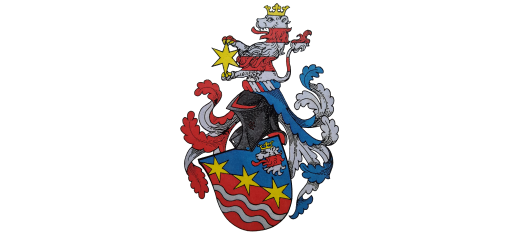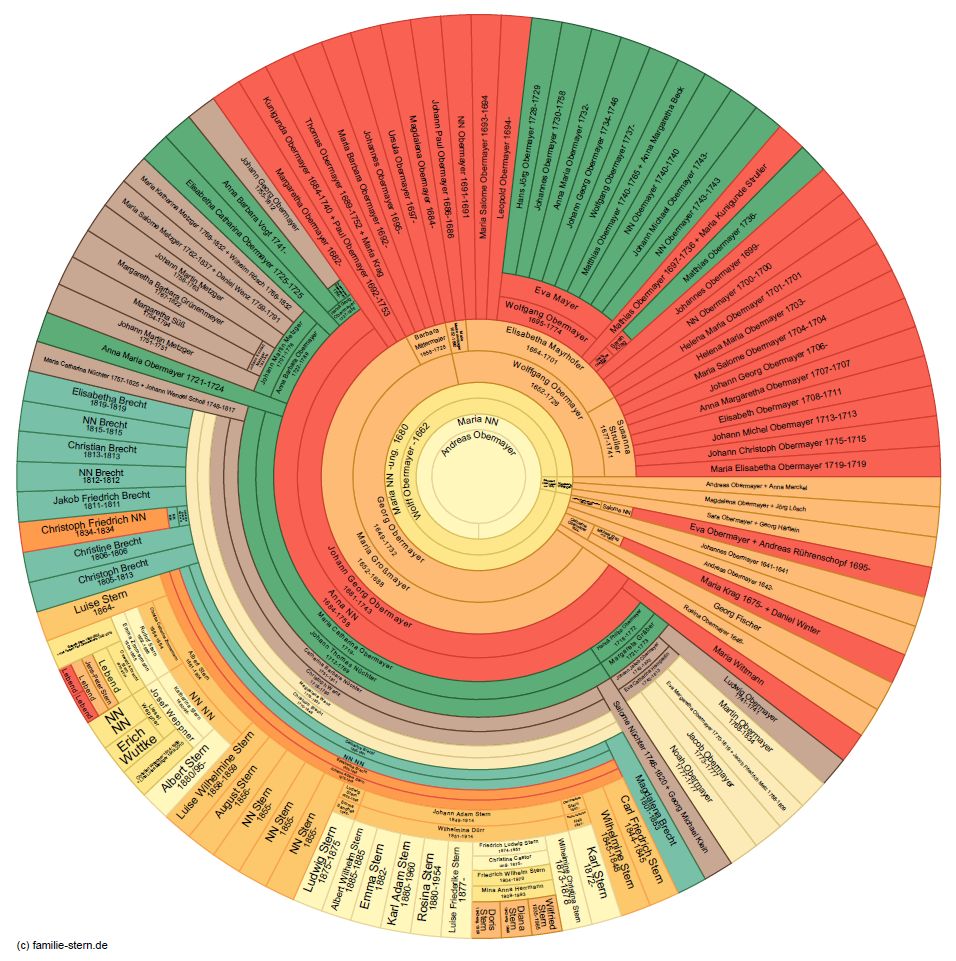Published: 24. August 2018, updated: 22. Oktober 2023
Introduction
During my research in Blankenloch/Baden, Germany, I came across an ancestral line that has been migrated from Upper Austria into the Franconian Alb in Germany, further to the region around the Hardtwald near Karlsruhe/Baden, Germany and to the Middle Rhine. One family member has gone to North America.
The story – as far as I could trace it to date – begins in the „Ländlein ob der Enns“, in about today’s Upper Austria. In the village Rittberg near Natternbach within the Hausruckviertel, in the parish Neukirchen am Wald, lived the family Obermayer, whose members – after the interpretation of the surname – were probably peasants and a kind of managers of a manorial farm. The family was Protestant.
To make the following explanations easier to understand, here are several overviews of the documented Obermayer descendants…
1. A classic overview in boxes…
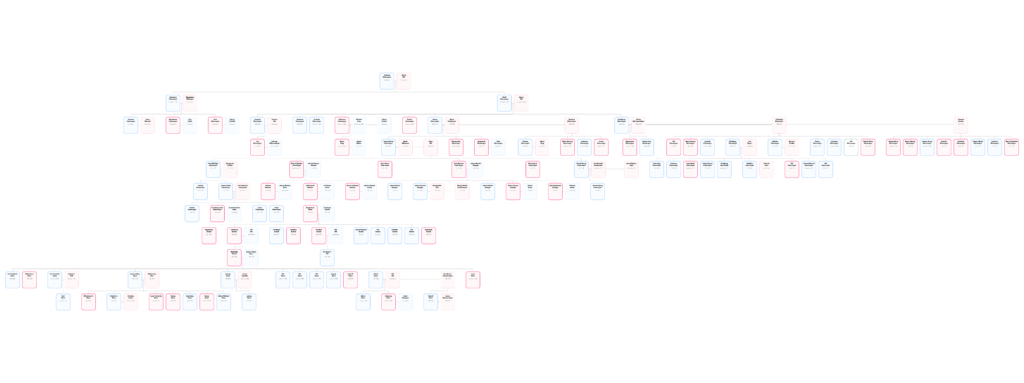
2. A pie chart…
3. A written descendant report…
Historical background and the time up to about 1638
During the Counter-Reformation in Upper Austria, the Protestants were increasingly restricted in the exercise of their faith. There were first emigrations, which the authorities tried to prevent by sanctions.
With the mandate of Emperor Ferdinand II, all non-Catholic lay preachers and schoolmasters had to leave the country from October 1624. Since there were no local pastors available, Italian priests were brought into the region, who often did not speak German and who now held Catholic worships in incomprehensible language. This caused the first riots. In Natternbach in January 1625, dean Blasius de Livo and the Italian pastor appointed by him were thrown with stones and chased away by several hundred peasants. Although this initially had no consequences, this was the beginning of further unrest that finally culminated in the dice game of Frankenburg and subsequently led to the Upper Austrian Peasants‘ War in 1626, in which the rebellious peasants were defeated by the Austrian and Bavarian troops in the battles on November 9, 1626 at Alkoven and November 15, 1626 at Pinsdorf.
What role the Obermayers played in the 1625 incidents in their neighboring village of Natternbach – or in the peasant uprisings in Upper Austria in general – is not known. The place of their parish Neukirchen am Wald was completely destroyed in a battle on September 19, 1626. It can be assumed that this epoch will not have passed with trace and inactivity at the convinced Protestants.
In the period that followed, the Counter-Reformation continued to intensify. The Protestants were oppressed in their homeland, e.g. civil rights were denied, their books were publicly burnt, and they were forced to attend Catholic worship and the Corpus Christi procession.
Many Protestants were so deeply rooted in their faith that they left their homeland in Upper Austria – losing much of their property and giving up contact with relatives, friends and neighbors. As „Exulant“ (exiles) or „Ländler“, as they were often named in the immigration places, they made their way to a new life. At that time, there were no large refugee flows from the Hausruckviertel, but smaller groups of younger men first explored possible settlement sites in order to find a place to stay for family members who would later follow.
The Protestant regions in Middle Franconia, which were destroyed and depopulated by the Thirty Years‘ War, were a popular destination.
After the investigation and a possible verbal agreement on the purchase of free-standing, often destroyed properties, the other people followed, mostly whole families, who were also joined by neighbors.
Hard-working, decent and religious people came to the places of immigration to help rebuild them. Nevertheless, the „foreigners“ were not necessarily welcomed by the returning locals, because it can be assumed that they had more cash through the sale of their homeland goods than the Franconian farmers, who had been hard hit by the long years of war. This made them unwelcome competitors when it came to buying unowned fields and houses.
So Wolff Obermayer went on the journey to this region.
In the book „Exulanten aus dem oberösterreichischen Hausruck- und Traunviertel in Franken“ by Manfred Enzner and Eberhard Krauss is mentioned a Wolff Obermayer, who witnessed on July 18, 1638 in Theilenhofen at the wedding of Zacharias Gruber „von der Grub“, parish Neukirchen am Wald in Austria with Eva Bannholtz from the parish Engelhartszell.
As the place of origin of Wolff Obermayer Rippberg [= Rittberg] in the parish Neukirchen am Wald is mentioned.
This entry can be found in the church register of Theilenhofen…

Beside the linked place Rittberg (today part of Natternbach) there is another place called Rittberg (today part of Steegen) in this region. The latter did not belong at that time to the parish Neukirchen am Wald but to the parish Peuerbach.
In the church documents of Natternbach baptisms and marriages are from 1631, funerals only from 1706 on listed.
On May 27, 1632 Martha, daughter of Sebastian Obermayer and Magdalena, was married there to Hannß Mairle, widower from Natternbach.
On January 27, 1638 Jacob Obermayer from Rippberg [=Rittberg ], son of the late Simon Obermayer and his wife Brigitte, was married to Regina Meyer from Untermaggau.
On February 11, 1638, the wedding of Bernhard Obermayer from Rippberg [=Rittberg ], son of Andreas Obermayer and his wife Maria with Magdalena Wirtinger from Hermatting [=Hörmating ] took place…

In the book „Exulanten aus dem oberösterreichischen Hausruck- und Traunviertel in Franken“ by Manfred Enzner and Eberhard Krauss is mentioned an Upper Austrian exile „Bernhard Obermayer living in Bubenheim„, whose origin is described as „from Land ob der Enns near Neukirchen am Wald [see Wolff Obermayer]“. He has the children Andreas, Magdalena and Sara.
This information can also be found in the article „Exulanten in den Registern der Evang.-Luth. Kirchengemeinde Theilenhofen (Dekanat Gunzenhausen)” by Herta Frank.
Here are the marriages of his children in the parish register of Theilenhofen…
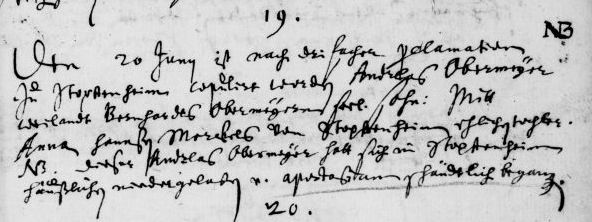


The fact that the children’s first names correspond to the first names of the wife and grandfather indicates that the two Bernhard Obermayer are the same person. The entry in the Catholic parish register of Natternbach has to be viewed in the context of the Counter-Reformation and the „formal“ denomination may have been temporary.
There are also entries by Wolff and Bernhard Obermayer in Karl Gröschel’s exile register, which was completed in 1937.
The fact that the Wolff Obermayer, who is mentioned in Theilenhofen, is really our ancestor, could not be finally proven, but the relationship is due to the frame conditions and dates very likely.
Even if nothing to Wolff Obermayer could be found in the
church documents of Natternbach (starting in 1631), it seems plausible that Bernhard was his brother and Wolff’s parents were Andreas Obermayer and his wife Maria.
This assessment is shared by Hans Navratil in „Familienblätter aus der Grafschaft Pappenheim„.
In Middle Franconia (about 1638 to 1712)
Wolff Obermayer is documented in 1638 as the owner of a property in Nennslingen called „Hochfürstlich brandenburgischer Bauernhof“.
The earliest mention of the Obermayers in the church registers there is at Maundy Thursday 1640 (April 2nd according to the Julian calendar). On this day a maid „Rosina, Ancilla beim Obermajer“ (Rosina, maid at the Obermajer) is listed…
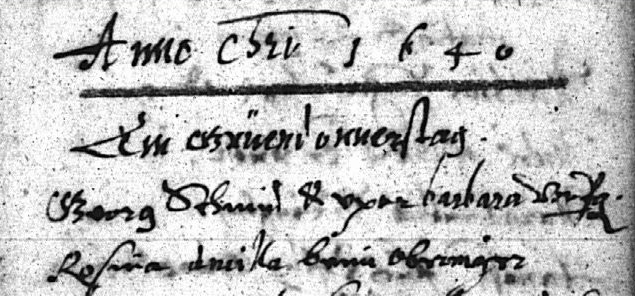
On April 18, 1640 the first documented child of Wolff Obermayer, named Leopold, was baptized in Nennslingen – this could be the reason, why the maid went to church alone on Maundy Thursday…
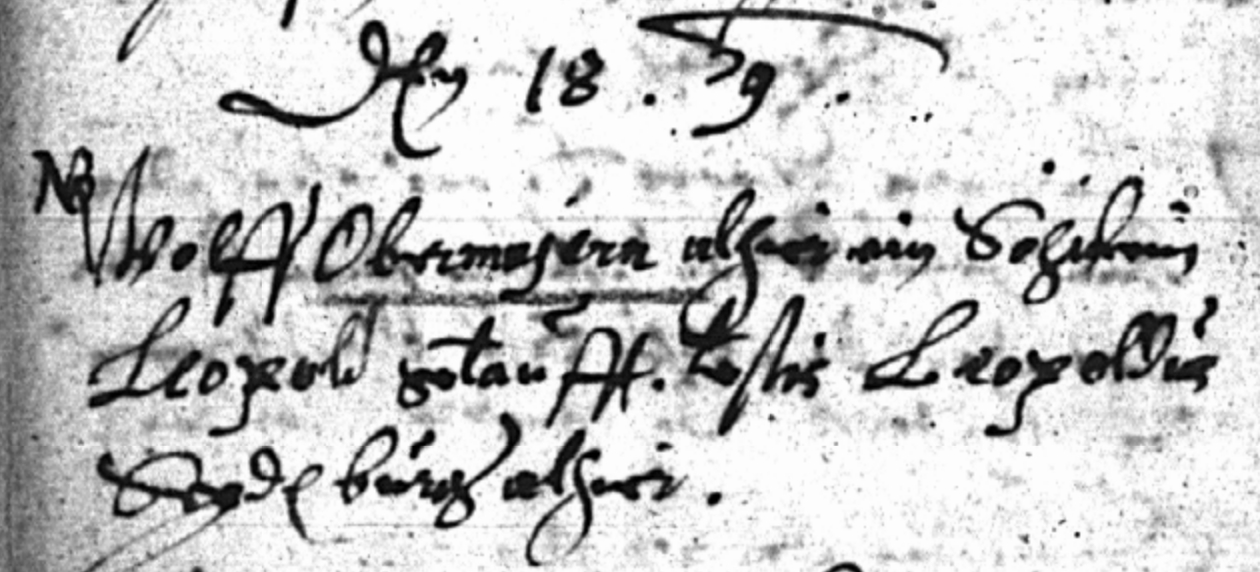
Wolff Obermayer is mentioned in Nennslingen on September 20, 1640 with his wife and a maid…

Between 1641 and 1647 Wolff was in Nennslingen several times witness at the marriages of Upper Austrian exiles. In the first years, there are few marriages between long-established residents and exiles. This only happened in the next generation.
On April 20, 1649 Georg Obermayer was born, the next generation in this line…

Wolff Obermayer was buried on February 8, 1662 in Nennslingen…

In 1675 „Wolf Obermayer’s widow Maria“ is mentioned as the owner of a house. Since his son Wolffgang died in 1726 and apart from these two there were no other Obermayers with the first name Wolff(gang) in Nennslingen at the time, the Maria mentioned in 1675 must have been the widow of the exile Wolff Obermayer. In 1680 this property belonged to a Simon Weixelbaum. Maria probably died around 1680. From 1680 to 1683 almost all burial entries in the church book are missing.
It can therefore be assumed that Wolff Obermayer – probably with his wife Maria – emigrated before 1638 from the parish Neukirchen am Wald in Upper Austria and – possibly after an intermediate station in Theilenhofen – settled in Nennslingen about 1638.
Further Obermayers could not be found in Nennslingen at this time. Just the similar names „Obenöder“ (from Obenödt in Noderbecker [=Natternbach] Parish in Upper Austria, today Oberned, part of Obertresleinsbach) and „Obernauer“ (also from Parish Natternbach) appear.
On June 4, 1645, a Hannß Oberauer got married there. One could assume that this was another son of Andreas Obermayer, in which case he would have died before June 4, 1645. However, the surname, Oberauer, is continuously and comparatively clearly distinct from Obermayer.
Our ancestor Georg Obermayer was a day laborer and Köbler (peasant). He married in 1680, probably in Nennslingen, Maria Großmayer. The marriage entries between 1680 and 1684 are missing in the local church record, and there was also no matching baptismal entry of Maria found.
An indication that Maria was a born Großmayer, is just found in the baptismal record of her daughter Kunigunda from August 24, 1684…

In the book „Exulanten in Stadt und Bezirk Weißenburg und Dekanat Heidenheim“ by Karl Gröschel (ed.) a Ferdinand Großmajer, son of Johann from Lindach in the Land ob der Enns is mentioned on June 3, 1673 in Nennslingen and also noted in his exile register.
According to the book „Die oberösterreichischen Exulanten im ehemaligen Brandenburg-Ansbachischen Oberamt Stauf-Landeck | Verzeichnis der oberösterreichischen Exulanten im Bezirk des ev.-luth. Dekanats Thalmässing“ by Walter Lehnert and Georg Barth the wedding of a Ferdinand Großmajer, son of the late Johann Großmajer, schoolmaster to Lindach deanary Gmunden in the Land ob der Enns with Margaretha Blob is listed on June 3, 1673 in Nennslingen.
Manfred Enzner and Eberhard Krauss documented this wedding under the parish of Laakirchen in the deanery of Gmunden in the book „Exulanten aus dem oberösterreichischen Hausruck- und Traunviertel in Franken“ as well.
In the church book of Nennslingen the mentioned marriage entry is as follows …
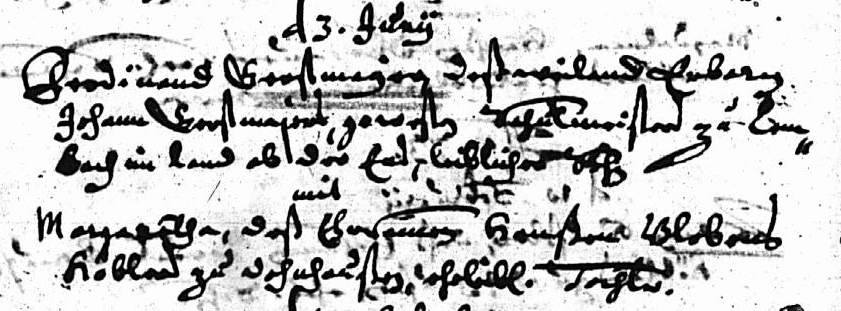
The proclamation of this marriage also took place in Thalmannsfeld…

Although currently not to prove, it can be assumed based on the timelines and the same place (Nennslingen), that Maria was a sister of Ferdinand.
The son Johann Georg Obermayer, baptized on April 6, 1681 in Nennslingen, is the next ancestor in our line…

While his parents died in Nennslingen, Maria at the age of 36 on June 10, 1688, …

Georg, who had married in the meantime again, on May 28, 1732,…

…Johann Georg, who was meanwhile a master weaver, moved away.
The living places of the early Obermayers in Nennslingen
In the second book about Nennslingen by Dr. Hans Deutscher, the „Häuserbuch“ (house book), one can learn a lot about the older buildings in the market community. For our ancestors, the period from about 1638 (immigration of Wolff Obermayer) to 1712 (emigration of Johann Georg Obermayer) is of interest. For this period, the „Verzeichnisse der einzelnen grundherrlichen Untertanen und deren Besitz“, the so-called „Salbücher“, are more or less continuously maintained documents that were evaluated for the house book. Interesting insights can be derived about some of the living quarters and possessions of the early Nennslingen Obermayers.
The following map only shows the positions. This does not mean that the buildings there today are the same as in the 17th century…
Positions related to our immediate ancestors are shown in green, those of other Obermayers in red.
List of places where our immediate ancestors lived
| Ancestors | Estate | Remarkd |
|---|---|---|
| Wolff Obermayer Maria born NN | [1] [2] | Both as a couple Maria as a widow |
| Georg Obermayer Maria born Großmayer | [1] [3] | George as a child Both as a couple |
| Johann Georg Obermayer | [3] | Johann George as a child |
[1] Farm estate „Hochfürstlich brandenburgischer Bauernhof“ [today Sparengasse 7]
In 1638 Wolff Obermayer was the owner of this property. He may have lived there from immigration until his death on February 8, 1662. In connection with a property opposite, he is still named as the owner in 1658.
In 1677 his eldest son Leopold became the owner. However, he became a farmer on the „Kappelhof“ in 1682, see property [4]. From then on, the younger brother Wolffgang Obermayer was the owner of this farm. In the „Salbuch“ of Ansbach is mentioned 1683…
Wolff Obermeyer possidiert einen Hof so zwischen Johann Friedrich Roth und Hannß Georg Blümlein ihren Gärten innen gelegen. Mit einer offenen Hofreith. An Gebäuden: Ein eingättig Haus, Stadel, Schweinestall, Keller, Backofen und ein Brunnen, welches alles um sich begreifen und halten mag bey 1/4 Tagwerk. Ist anhero vogt-, steuer-, dienst-, zins- und lehenbar. Dabei ist ein klein Gärtlien hinter dem Stadel gelegen, sind etliche Zwetschgenbäum darin. Hält mitsamt dem Hausplatz bei 1/4 Tagwerk.
Source: Hans Deutscher: Marktgemeinde Nennslingen – Band II: Häuserbuch
Wolffgang Obermayer was a farmer and juror. In a court record of May 30, 1702, however, he himself is mentioned as a defendant due to a fight…
(..) Hans Adam Hoffmann. Müller. Michael Kruchbaum. Beck. Christian Korner. Beckengesell. Gabriel Mittermeier. Bauer und Wolfgang Obermeier. Gerichtsmann [Schöffe], sämtlich allhier. haben sich nächsthin im herrschafllich-Brandenburgischen Wirtshaus bei Matthias Ammersdörfers Wittib [Witwe] miteinander verunwilligt und zu Schlägen kommen, dahero sind die ersten vier jeder pro 45 Kreuzer abgestraft worden. Obermeier aber, als welcher Obigen zur Schlägerei Anlaß gegeben, pro ein Gulden 30 Kreuzer [also das Doppelte]. Samuel Winter aber, welcher sich bei solcher Aktion zum Friedenmachen gebrauchen lassen, jedoch einige Schlag ausgeteilt. für 30 Kreuzer. (..)
Source: Hans Deutscher: Marktgemeinde Nennslingen – Band 1: Chronik
After the death of Wolffgang Obermayer in 1726, the property was taken over by his son Mathias.
[2] Farm estate [today Weißenburger Str. 7]
In 1649, this estate was owned by the exile Leopold Seydel, the godfather of our ancestor Georg Obermayer.
1667 „Wolff Obermayer“ was the owner of the property. That should have been the son Wolffgang, since the exile Wolff Obermayer died in 1662. Another possibility could be that the farm has not yet been transferred to the widow Maria and this was carried out later in the official documents.
In 1675 „Wolf Obermayer’s widow Maria“ was the owner. As already stated above, the mentioned Maria was probably the widow of the exile Wolff Obermayer. In 1680 the property belonged to Simon Weixelbaum and no longer to the Obermayer family.
[3] Farm estate „Köblerhof“ [today Kellergasse 13 and 15]
The outermost house on the edge of Nennslingen, right next to the footpath to the „Schwabenmühle“, was built around 1390/92 and was later inhabited by our ancestor Georg Obermayer. According to the information in the house book, he has been the owner around 1660/62…
Georg Obermeyer, Taglöhner, hat innen die Behausung samt einem Stadel und einem Garten hinter dem Haus so ungefähr 3/4 sein sollen, liegt zwischen Matthias Merkenschlager am Ortsende bei der Brühlwiesen. Zu diesem ist vererbt worden ein Milchgruben auf der sog. Brühlwiesen bei dem Stauff Brunnen, welche fürohin stetig bei dem Haus sein und bleiben soll.
—
Georg Obermajer, so besitzt das Gut gelegen hinter dem Ulrich Schlund bei der Stauff Spiegel und ist den Schenken vogtbar, lehenbar und zinsbar und gibt jährlich auf Michaelis 7 Pfennig, eine Fastnachthenne und seinen gebührenden Teil Vogthabern. Zu diesem Gut gehörig: Ein Garten ungefähr 3/4 groß, hinter dem Haus, unten an die Wiesmahd, der Priel genannt, neben an Hans Bayers Breitung, uf der andern Seitn an Ulrich Schlundens Garten stoßend und gibt den kleinen Zehent dem Pfarrer zu Nennsling.
Source: Hans Deutscher: Marktgemeinde Nennslingen – Band II: Häuserbuch
Since Georg Obermayer was born in April 1649, he was apparently very young when the farm was attributed to him – if the year numbers in the house book are correct. This is probably related to the death of the father Wolff in 1662. But it may also have been an addendum. However, it must have been our ancestor Georg Obermayer, because around 1715 he sold the property to his son Thomas Obermayer, the firstborn of his second marriage to Barbara Mittermayer.
On January 11, 1727, Thomas Obermayer sold half of his estate to his cousin Thomas Mittermeier for 275 guilders. From this time on there were two different parts of the house. Thomas Obermayer lived further in the front part [today Kellergasse 13]. The back part [today Kellergasse 15] was occupied by Thomas Mittermeyer.
Georg Obermeyer lived in the back part until his death in 1732. His second wife, Barbara Mittermayer, had already died in 1725.
[4] Farm estate „Kappelhof“ [today Gersdorfer Straße 9]
Around 1380, the „Herren von Stein“ built a Catholic chapel in honor of St. Leonhard. The income from the so-called „Leonhardszehnt“ (a kind of tax), to which a wide variety of fields were assigned, served to maintain it structurally. In order to manage this, a rural property with a barn was built in the immediate vicinity of the chapel, which was given the name „Kapellenhof“ (short: „Kappelhof“, English expression: „chapel farm“). The respective owner was the „Kappelbauer“ („chapel farmer“), who kept the proceeds brought in his barn and had to deliver the part intended for the authority to Hilpoltstein at the appropriate time. With the Reformation, the chapel became orphaned. Its ruins have not existed since the middle of the 19th century at the latest. The terms „Kappelhof“ and „Kappelbauer“ have remained, and the „Kappelweg“ („chapel way“) is still there today.
The first owner of the „Kappelhof“ known by name was Michael Pirlwein in 1549. In 1645 Tobias Merkenschlager was the owner, an exile from the Ahkirchen parish in Upper Austria and probably an ancestor of Maria Merkenschlager, the first wife of Wolffgang Obermayer.
He was succeeded by Leopold Obermayer. 1682 is mentioned…
Leopold Obermayer gibt jährlich dahin zwei Metzen Dünkel oder Rauhgetreid. zwei Metzen Haber und 4 Pfund Zins.
Source: Hans Deutscher: Marktgemeinde Nennslingen – Band II: Häuserbuch
Leopold Obermayer died on March 27, 1698 at the „Kappelhof“. Since this farm was part of the parish of Thalmannsfeld, his burial is documented there…

His widow Salome married the widower Gabriel Mittermaier on May 16, 1699, who was a brother of Barbara Mittermaier, the second wife of our ancestor Georg Obermayer, see property [6].
On May 17, 1719, after the death of their mother Salome, the children sold the „Kappelhof“ as heirs to their designated brother-in-law, Andreas Rührenschopf, who later became Eva Obermayer’s husband (marriage June 27, 1719). Wolffgang Obermayer witnessed this transaction.
[5] Farm estate [today Sparengasse 2]
Catharina Obermayer, the sister of Leopold, Georg and Wolffgang Obermayer, is the owner of this property in 1669, which belonged to Palatinate in earlier times. After their marriage on February 7, 1670, her husband Michael Krag was registered as the owner. Around 1674, Catharina Obermayer as widow married Georg Fischer, who became the owner of the farm from then on. In 1708 Maria Krag, a daughter of the first marriage, inherited the farm.
[6] Farm estate [today between Marktplatz 14 and Weißenburger Straße 1 – demolished]
For the sake of completeness, this property is mentioned, which was owned by Wolff Mittermaier, the father of Barbara Mittermaier, the second wife of our ancestor Georg Obermayer…
1667 Wolf Mittemeyer hat innen die Behausung zwischen Georg Cröner und Paul Strullers Nebenhaus.
—
1687 Wolfgang Mittemayer besitzt die Behausung zwischen Paulus Struller und Hans Michael Heibeck. Ist den Schenken vogtbar und dienstbar von dem Stadel eine Fastnachthenne. Die Behausung ist heideckisch Lehen.
Source: Hans Deutscher: Marktgemeinde Nennslingen – Band II: Häuserbuch
After the death of her husband on February 13, 1699, her son Gabriel was initially designated as the heir. However, he married Salome, Leopold Obermeyer’s widow, on May 16, 1699 at the Kappelhof, see property [4]. Instead of him, the future son-in-law and husband of Magdalena Mittermaier, Matthias Schlund, took over the farm in 1699.
Descendants of the Obermayers still live in Nennslingen today, and some of the properties are owned by them.
The mystery about the wife(s) of Johann Georg Obermayer (1712 to 1716)
We don’t learn anything about the residence of Johann Georg Obermeyer in the house book. During his childhood and youth, he must have lived with his parents in the Köblerhof (property [3]).
Accorting to an entry in the church record of Nennslingen he married on June 14, 1712, in Höttingen Maria, widow of a weaver and „Steiner“ (person, who was commissioned with demarcation of borders) Peter Höhberger from Höttingen…

In the church record of Höttingen the wedding is confirmed ……

The exact context of Maria’s first marriage and her origin could not really be solved – even after a new investigation in early 2022. For better understanding and own assessment, I describe the findings so far in more detail below.
Maria’s first marriage to Peter Höhberger (also mentioned as a weaver and “Steiner”) took place on January 20, 1702 in Höttingen, so she was born Wittmann and daughter of the Köbler Paul Wittmann from Göppersdorf…
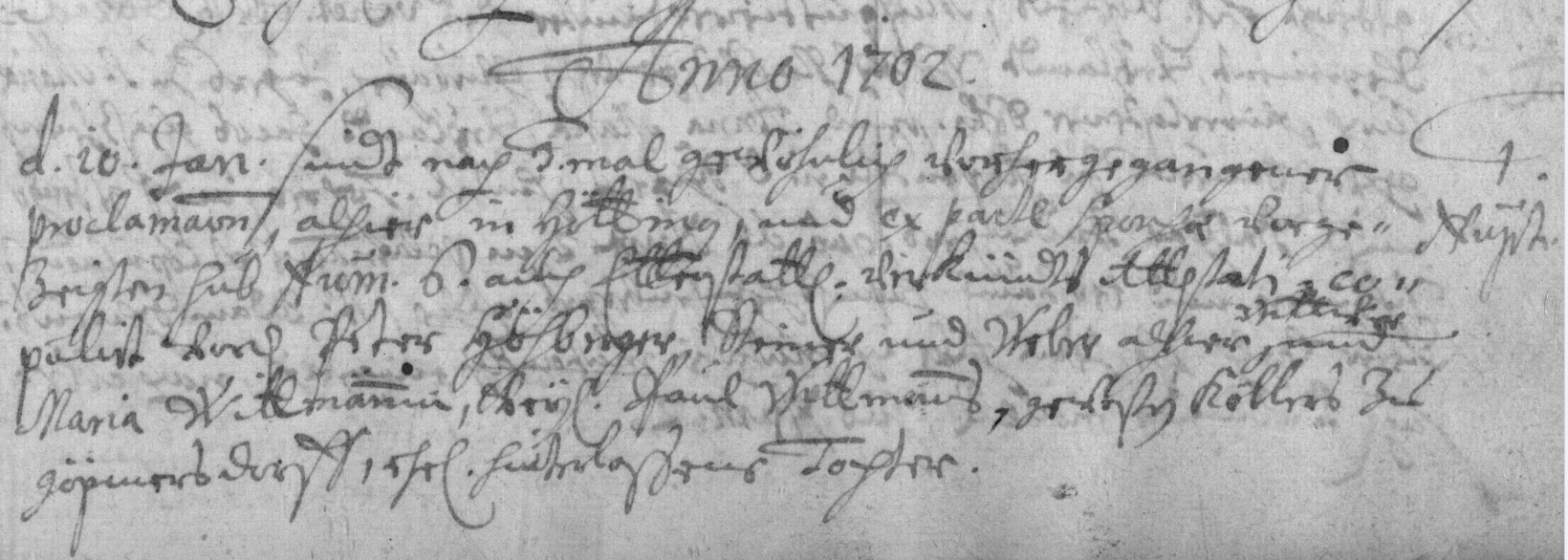
On January 4, 1712, a Peter Höhberger was buried in Höttingen at the age of 82 (born 1630), so he would have died about half a year before his wife remarried. There are no other burials with this name. If he had been Mary’s first husband, he would have married her at the age of 72. The deceased in 1712 was probably also those Peter Höhberger, who married a Dorothea in Höttingen on February 5, 1661, who at that time was already a widow of Caspar Schmidtlin and was buried on 2 September 1701 at the age of 88 years in Höttingen (born 1613).
In temporal terms, this could basically fit together, but the fact that Peter Höhberger married a woman 17 years older, Maria Wittmann then a 72-year-old husband and after his death a 31-year-old, does not seem really realistic.
Peter Höhberger’s father named Georg had three other sons besides Peter: Georg (married January 19, 1668), Paul (married May 26, 1674) and Lorenz (married September 5, 1676).
No descendants of Peter Höhberger and Dorothea were baptized according to the Höttingen church record. However, both Peter and Dorothea appear between 1661 and 1681 several times as godparents.
Only one son named Georg was baptized by his brother Georg in Höttingen.
The brother Paul had the children Christoph, Anna Maria, Georg Christoph, Paul, Anna Margaretha, Barbara and Johann Paul.
The brother Lorenz had children named Anna Maria, Georg Adam, Johann Paul, Eva Maria and Maria Margaretha.
There is no Peter.
Either the early baptismal records of Peter and Georg’s children were not recorded, or the baptisms took place elsewhere.
I have not been able to find any proof in the church registers of Höttingen and the surrounding area, but it seems that Peter Höhberger, who married Maria Wittmann on January 20, 1702, and Peter Höhberger, who died shortly before Maria’s second marriage to Johann Georg Obermayer, were not identical, but the second was the uncle or father of the first.
So far I could not find the baptism of Maria Wittmann. On February 5, 1662, an Anna Maria Wittmann was born in Göppersdorf according to the Ettenstatt church record, which is the basis there. Her father’s name was Caspar, not Paul, and she would have been 20 years older than Johann Georg Obermayer.
On October 21, 1690, the burial of a Paul Wittmann is recorded, who was 83 years old (born 1607) and possibly the father of the wanted Maria Wittmann. Anyway, her father had already died at her first marriage in 1702.
Perhaps, after the online-publication of further church registers or the lists of communicants from Höttingen, a hint will appear by chance.
Maria Wittmann obviously did not bring any children into her marriage with Johann Georg Obermayer, because the second marriage of Peter Höhberger with Maria remained childless after my research.
…and was buried on 2 September 1701 at the age of 88 years in Höttingen…
About four years after his marriage in Höttingen, Johann Georg Obermayer appears on August 29, 1716, at the (emergency) baptism of his son Hannß Philipp in Büchig near Karlsruhe, Baden, about 200 kilometers from Nennslingen. The note in the church record of Blankenloch clearly indicates his original origin Nennslingen „auß dem Anspachisch Zu Nentzling“…

According to the wording, „(ohn)längst nach Büchig gezogen. Anna ejusdem uxor.“, he was already married to Hannß Philipp’s mother named Anna at that time and had moved to Büchig shortly before.
About the period between the marriage in Höttingen with Maria, born Wittmann and the arrival in Büchig near Blankenloch as well as the reasons to emigrate (with or without Maria) towards Blankenloch, can only be speculated.
Johann Georg Obermayer is mentioned in Blankenloch in all local entries with a wife named Anna, the name Maria does not appear.
Anna Maria Wittmann, born in Göppersdorf in 1662, can be eliminated as the Anna mentioned in Blankenloch and thus as our ancestor, since she would have been 54 when the first child was born and 65 when the last child was born. In addition, her year of birth differs by 22 years from that calculated from her burial (* 1684). The marriage would also have remained childless from 1712 to 1716, until they „suddenly“ had children from 1716 onwards. It seems rather unrealistic that all the children that might have been born during the four years died elsewhere, although theoretically that could be.
Recent research by the author of the Ortssippenbuch of Blankenloch in the original church records has disproved that Anna was Catholic and her middle name was Catharina, even if this was recorded in the book more than twenty years ago.
Neither in the church records Blankenloch nor in the records of Höttingen, Nennslingen or Ettenstatt hints to two different wives were found. Available Catholic church registers were also consulted.
The thesis recently formulated by an Obermayer descendant in the USA that the pastor did not register the marriage so that the family could “save face” with regard to the premarital birth of the first child can also be dismissed as unrealistic. The pastors were officially obliged to make entries, and the Obermayers had recently moved there as „strangers“. Why should the pastor have protected them?
The proven facts can be summarized as follows:
1. Johann Georg Obermayer recorded in Nennslingen and Blankenloch is clearly the same person.
2. Johann Georg Obermayer was married to Maria Wittmann in Höttingen in 1712, but had children in Büchig / Blankenloch only with a wife named Anna.
3. With his wife Anna, he moved to Büchig shortly before the baptism of his first child around 1715/16.
Anna was obviously already a Protestant before she married Johann Georg Obermayer.
Maria and Anna were probably not the same person. If this were the case, the following can be assumed to be relatively realistic:
1. Maria died on the journey or in the Franconian region – probably not in Höttingen, Nennslingen or Ettenstatt, because a suitable burial entry was not found there.
2. Johann Georg married somewhere – not in Blankenloch or the verified surrounding locations, but probably in the middle/end of 1715 and shortly before he moved there – to Anna, whom he met on the way.
3. He had no children with Maria, or they died before moving to Büchig.
There are several sources on the internet, according to which Anna was a born „Bane“. This is definitely not true. This myth is probably due to a transmission, translation or communication error between the pastor G. Flecht of Blankenloch and the author of the Overmyer Genealogy of 1905, John C. Overmyer. The contents of the letter of the pastor is reproduced in the book „Overmyer History and Genealogy 1680-1905“ as follows…
(..) that a citizen named John George Obermayer was born at Nentzlingen, in Anspach, Bavaria, in 1680, the day and month not being given, and was married to Ann Bane, date not given, became a citizen of Blankenloch, Baden, some time previous to 1718. (..) John George Obermayer was a weaver by occupation in Blankenloch, and a copy-holder later in Buechig, a suburb of Blankenloch. (.. ) the child(..) John George, born Oct. 27th, 1727 (..) was baptized the day following his birth, October 28th, by John Christian Ebersole, pastor of Blankenloch and Buechig, Baden. The witnesses of the baptism were John George Bane, a citizen and weaver, Henry Bane, a citizen of Buechig (..). The foregoing data has been copied from the Register of Baptisms, and the Church Records of Blankenloch, Baden. (..) Pastor Flecht, in his explanatory remarks says, „I find in the death records of this parish, that John George Obermayer, the emigrant’s father, died August 12th, 1743, aged sixty- three years, and there is no record of his mother’s death to be found and the supposition was, that after the deat hof her husband, she with her youngest son, emigrated to America, but no such facts can be found in history or tradition, as her name does not appear on the list of passengers that landed with him, neither do we find any mention of her as being with him, in his adopted country, at any time.“
In fact, the as „John George Bane“ and „Henry Bane“ described witnesses of the baptism of Johann George Junior (Hannß Jörg) Obermayer are registered as as Johann Georg (Hannß Jörg), Raupp and Heinrich Raupp…

From whom and why the family name „Raupp“ was transferred to „Bane“ and how it was concluded that Anna was supposedly a born Bane (-> Raupp), remains unexplained. It is possible that this was concluded due to the same witnesses with the surname Raupp, who frequently occurs during the further baptisms of the family.
Anna would have to be a born Raupp according to the logic of the above text. Since Raupp is a typical family name in the Blankenloch region, even if it occurs occasionally in Nennslingen , their origin would be more there, because in the Nennslingen area.
Noa Raupp, the father of the witness Johann Georg (Hannß Jörg) Raupp, had in his third marriage a daughter named Anna Maria, who was baptized on August 16, 1699. For the thesis that she is the wife of Johann Georg Obermayer, there is no evidence. Pastor Flecht obviously did not find a suitable wedding entry in Blankenloch around 1905 either. Her date of birth also clearly does not match Anna’s burial entry.
In my database, I have Maria, born Wittmann and Anna NN as two different wives.
Anna NN is our ancestor, unfortunately nothing further is known about her origin that could be proven.
In Baden (from 1716)
Johann Georg and Anna had six children baptized in Blankenloch:
- Hannß Philipp on August 29, 1716
- Maria Catharina on February 9, 1719
- Anna Maria on January 28, 1721
- Anna Barbara on July 8, 1722
- Elisabetha Catharina on September 5, 1725
- Hannß Georg Junior on November 28, 1727
The youngest son Hannß (Johann) Georg Obermayer emigrated to North America in 1751 at the age of 23. He is reported in more detail in another article…
Johann Georg Senior died on 12 August 1743 at the age of 62 in Blankenloch…

Pastor Flecht of Blankenloch did not find a burial record for Anna and suspected she emigrated to America. In fact, Anna died at the age of 74 years on May 27, 1858 in Graben, a neighboring village of Blankenloch…

Probably she spent the last years as a widow there with her daughter Maria Catharina, who was baptized on February 9, 1719 in Blankenloch, the older sister of the emigrant Hannß Georg Obermayer…

She is the next generation in our ancestral line and married on January 18, 1746 in Graben the „Beisasse“ or „Hintersasse“ Johann Thomas Nüchter, whose family had moved from Breitenborn in the Hanau area (near Frankfurt Main, Germany) to Graben…

A second cousin of Johann Thomas Nüchter named Anna Martha Koller (married Reitz) emigrated to America with her family almost at the same time as Hannß (Johann) Georg Obermayer. The two may have met there. This is also explained in more detail in the article already mentioned…
Johann Thomas and Maria Catharina Nüchter lived in Graben and had at least three daughters, Salome, baptized on October 24, 1746, Maria Catharina, baptized on March 17, 1757 and Catharina Barbara Nüchter, the next ancestor in this line.
Johann Thomas Nüchter was buried on 27 August 1769 in Graben…

A funeral entry for Maria Catharina Obermayer could not be found in Graben.
The baptism of the daughter Catharina Barbara Nüchter took place on January 7, 1751 in Graben.

Catharina Barbara was made pregnant in 1774 by the married master saddler Christoph Wenz from Graben, who was 32 years older. This is evident from the entry of the baptism of the daughter Magdalena Wenz “aus Ehebruch” [=from adultery]…
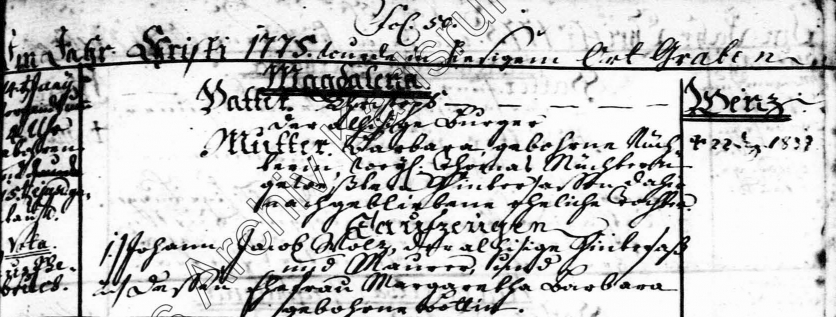
Since she was described on February 11, 1811, at her burial in Graben at the age of 60 as „unmarried daughter“, she did not marry…
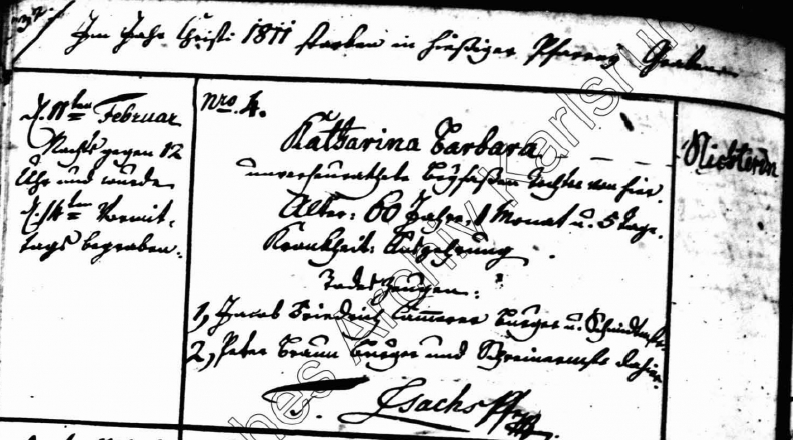
Christoph Wenz died in Graben on February 8, 1780, at the age of 60. It is not yet known whether and how he took care of his illegitimate daughter and her mother. The first search for a paternity file in the state archive of Baden-Württemberg was unsuccessful.
Magdalena Wenz later got married in Graben as well. She had ten children with her husband, the hussar and later farmer Christoph Brecht and spent her whole life in Graben before she died there on December 22, 1837, at the age of 62…

Her husband Christoph died on May 26, 1846 also in Graben…
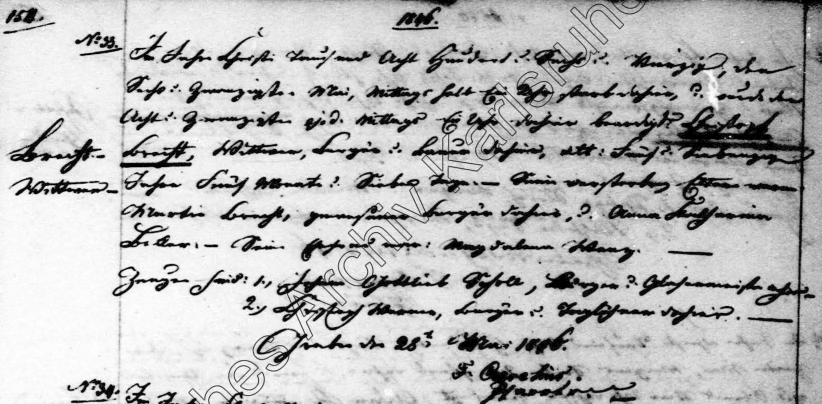
The second oldest daughter Catharina was baptized in October 1802 in Graben, there are contradictory entrys to the exact day….
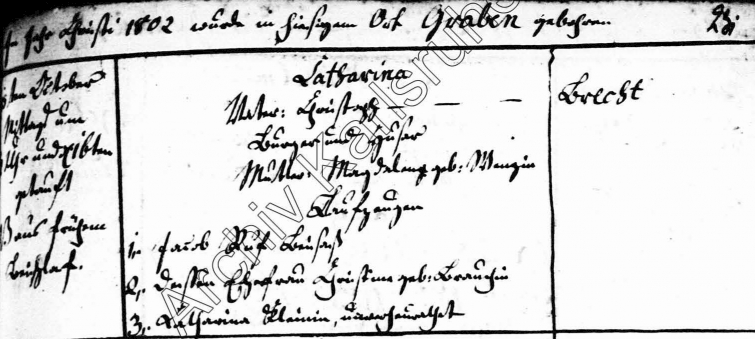

She bore on January 19, 1822, in Graben, an illegitimate daughter of an unknown father, who was christened Elisabetha in Graben on January 21 and received the mother’s surname…

Catharina Brecht probably never married either.
Elisabetha Brecht married on March 27, 1843 in Leopoldshafen Johann Adam Stern Junior…
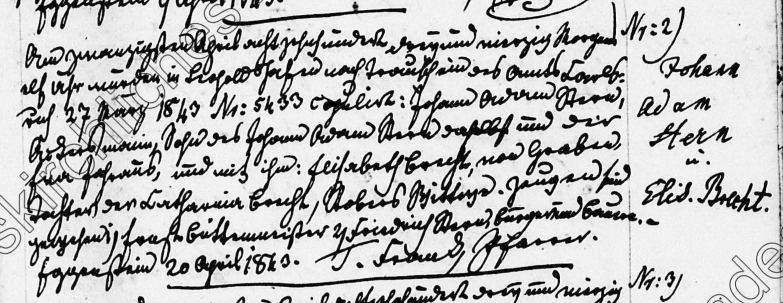
She lived in Leopoldshafen, where her mother Catharina died on February 9, 1861 at the age of 58 years. She will have lived there with her daughter.
The story is continued in the Stern family chronicle (there from the year 1843 on, German only)…
Topographic view
Finally, an overview of our Obermayer descendants in a kind of topographical map, where the contour lines represent the annual discs, dark areas are earlier years, light areas are later years.
Clicking on the image opens the interactive view. There, the colored map only appears after pressing the „Freeze“ switch left at the top.
Note: Because the „mouse-over data“ for the people marked as alive are fictitious and unknown data are estimated automatically, so no data should be taken from the topographic view. This is for illustrative purposes only.
If you discover errors or have more information about the named persons, I would be grateful for a hint.
Source documents and background reading
| Author (s) | Title | Publisher / Offer | Year | ISBN | Remarks |
|---|---|---|---|---|---|
| Bender, Heinz | 650 Jahre Blankenloch 1337 - 1987 | Gemeinde Stutensee | 1987 | - | - |
| Bender, Heinz | Vergangenheit und Zeitgeschehen. Eine Chronik. Blankenloch, Buechig, Schloss Stutensee | Gemeinde Stutensee | 1995 | - | - |
| Deutscher, Hans | Marktgemeinde Nennslingen - Band I: Chronik | Riedel, Gunzenhausen | 1998 | 300003868X | - |
| Deutscher, Hans | Marktgemeinde Nennslingen - Band II: Häuserbuch | Riedel, Gunzenhausen | 1998 | 300003868X | - |
| Dussel, Konrad | Graben - Vom Bauerndorf zur modernen Industriegemeinde | Ubstadt-Weiher | Verlag Regionalkultur | 2006 | 978-3-89735-439-5 | - |
| Enzner, Manfred | Krauß, Eberhard | Exulanten aus dem oberösterreichischen Hausruck- und Traunviertel in Franken | Gesellschaft für Familienforschung in Franken e.V. Quellen und Forschungen zur fränkischen Familiengeschichte, Band 29, Nürnberg | 2014 | 978-3-929865-63-9 | - |
| Frank, Herta | Exulanten in den Registern der Evang.-Luth. Kirchengemeinde Theilenhofen (Dekanat Gunzenhausen) | Gesellschaft für Familienforschung in Franken e.V. Blätter für fränkische Familienkunde, Band 17, Nürnberg | 1994 | - | - |
| Givaudan, Scott | Johann Georg (Obermeyer) Overmire (1727 - 1805) | WikiTree | last modified 9 May 2018 created 4 Mar 2016 retrieved 6 August 2018 | - | - |
| Gröschel, Karl | Exulanten in Franken | Jahrbuch für Fränkische Landesforschung herausgegeben vom institut für Fränkische Landesforschung an der Universität Erlangen 2, Verlag von Palm & Enke in Erlangen | 1936 | - | - |
| Gröschel, Karl [Hrsg.] | Exulanten in Stadt und Bezirk Weißenburg und Dekanat Heidenheim | Verein für Heimatkunde, Weißenburg | 1935 | - | - |
| Gröschel, Karl | Exulantenkartei | Gesellschaft für Familienforschung in Franken e.V. | 1937 | - | GFF Exulantenkartei (Members only) |
| Lehnert, Walter | Barth, Georg | Die oberösterreichischen Exulanten im ehemaligen Brandenburg-Ansbachischen Oberamt Stauf-Landeck | Verzeichnis der oberösterreichischen Exulanten im Bezirk des ev.-luth. Dekanats Thalmässing | Gesellschaft für Familienforschung in Franken Freie Schriftenfolge Band 14, Neustadt/Aich | 1962 | - | - |
| Navratil, Hans | Familienblätter aus der Grafschaft Pappenheim | Gesellschaft für Familienforschung in Franken | - | GFF-Sign. DA0032 | - |
| Overmire, Laurence | Capt John George Overmire | Find A Grave | added 23 Sep 2005 retrieved 6 August 2018 | - | - |
| Overmyer, Barnhart B. | John C. | Overmyer History and Genealogy 1680-1905 | Chas. S. Beelman, Printer, Fremont Ohio | 1905 | - | - |
| Rusam, Georg | Österreichische Exulanten in Franken und Schwaben. Einzelarbeiten aus der Kirchengeschichte Bayerns | Herausgegeben vom Verein für bayerische Kirchengeschichte unter verantwortlicher Schriftleitung von Dr. Helmut Baier. 63. Band, Degener, Neustadt a.d. Aisch | 1989 | 3768641252 | - |
| Scheidle, Walter August | Ortssippenbuch Blankenloch - Büchig und dem Studt | Heimat- und Museumsverein Blankenloch-Büchig | 2001 | 3-00-008164-X | - |
| Scheidle, Walter August | Ortssippenbuch Leopoldshafen (Schröck) | Eggenstein-Leopoldshafen | Gemeinde Eggenstein-Leopoldshafen | 2015 | 978-3-00-045372-4 | - |
| Authors, see respective version history | Exulantennamen im Raume Weißenburg | Stadtwiki Weißenburg Volkshochschule Weißenburg und Umgebung e.V. Pfarrgasse 4 91781 Weißenburg | retrieved 9 September 2018 | - | - |
| Authors, see respective version history | Wikipedia, the free encyclopedia | Wikimedia Foundation Inc. 149 New Montgomery Street Floor 6 San Francisco, CA 94105 USA | - | - | The used articles are linked. |
| - | Church books of Blankenloch, Eysölden, Graben, Höttingen, Leopoldshafen, Nennslingen, Thalmannsfeld und Theilenhofen | Archion Kirchenbuchportal GmbH Balinger Str. 33/1 70567 Stuttgart | - | - | The pictures of church books contained in the article are taken from official pdf downloads. I have written permission to publish. Please follow the copyright notice. |
| - | Church books of Natternbach | Matricula Online ICARUS – International Centre for Archival Research Erdberger Lände 6/7 A-1030 Wien | - | - | Matricula Terms of use... |
| - | Das Geschichtliche Orts-Verzeichnis | CompGen Verein für Computergenealogie e. V. Geschäftsstelle c/o Horst Reinhardt Piccoloministraße 397a 51067 Köln | - | - | The used articles are linked. |
| - | Index Personarum | Gesellschaft für Familienforschung in Franken e.V. | 2018 | - | - |
 |
| Dieses Werk ist lizenziert unter einer CC BY-NC-SA 4.0 Lizenz. Ggf. zu beachtende andere Lizenzrechte bleiben hiervon unberührt. Dies gilt insbesondere für Fotos aus Kirchenbüchern und die Verwendung unseres Familienwappens (siehe Impressum)! |
| This work is licensed under a CC BY-NC-SA 4.0 License. If applicable, other license rights remain unaffected. This applies in particular to photos from church books and the use of our family coat of arms (please refer to the imprint)! |
| Copyright © by Jens-Peter Stern | familie-stern.de |
